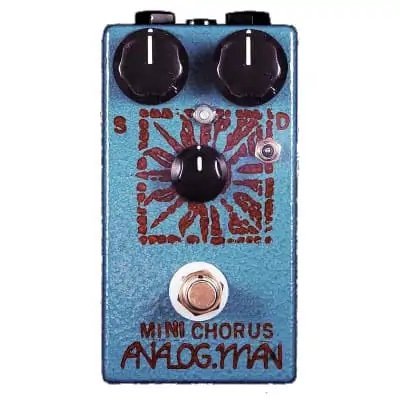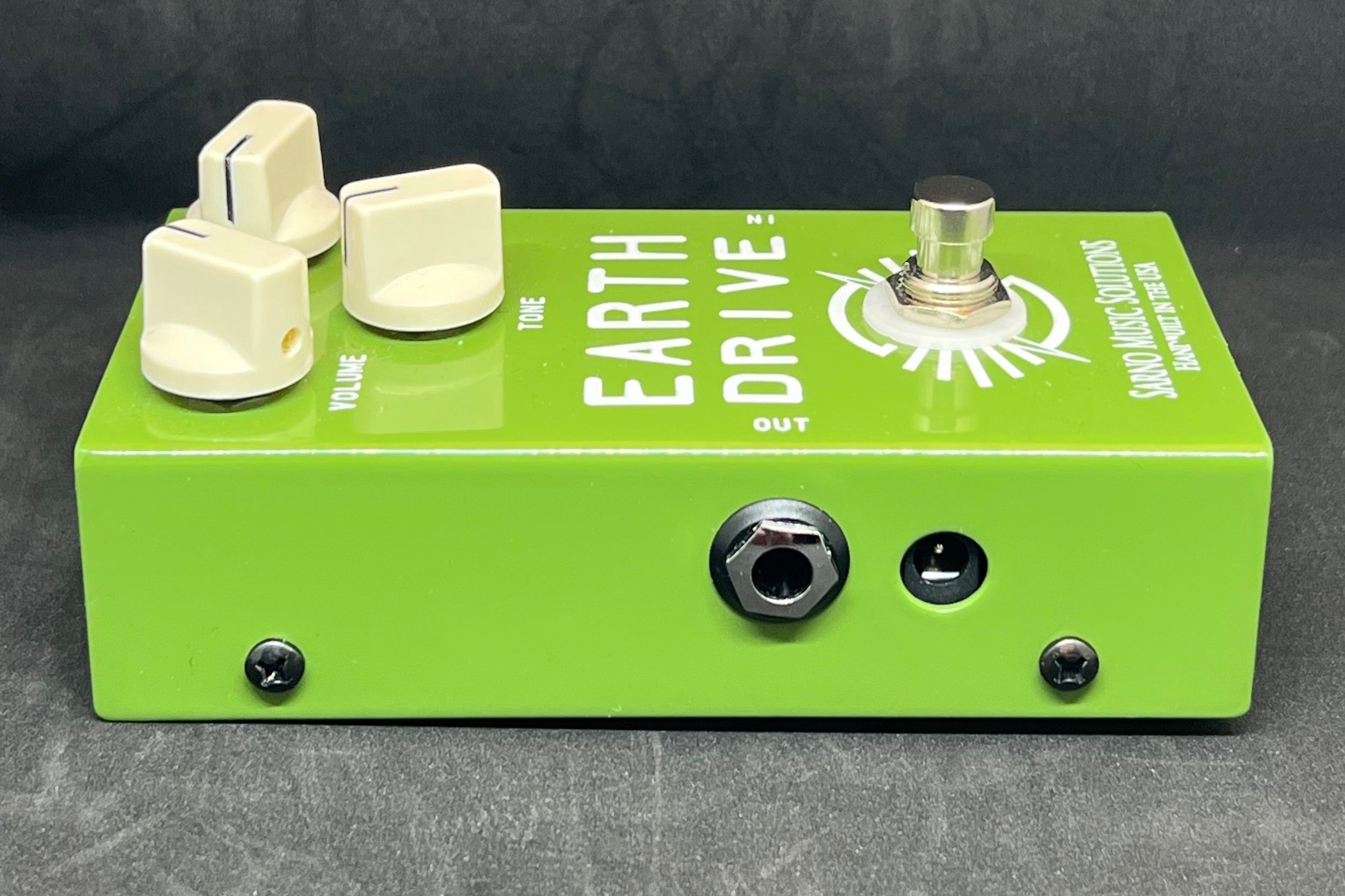From Saturation to Overdrive: Exploring the Versatility of the Sarno Earth Drive Pedal
It's intriguing to consider that three decades ago, we had a limited number of options when it came to guitar pedals. Nowadays, the tables have turned, and at times, it feels as if we have too many options. Options are a good thing, but there comes a point where there are so many options that many of the most incredible options get hidden from the masses, much like what is happening in the music business right now. The most interesting music is not what's accessible through the mainstream.
No style of pedal fits into this category more than overdrive pedals, which outnumber all other pedals by far. Everyone makes an overdrive pedal. If my grandma were alive, she would make one, too.
But just because you can doesn't mean you should. Yes, I can be a crank-yanker when discussing gear. I'm sensitive to tone and variations. Simply knowing how to make a circuit doesn't make you an expert. Understanding the technicality is essential. I'm not looking to underscore that. But, we often forget the least tangible attribute needed to make great pedals... Taste.
The best pedal makers have great taste. Often, what makes one pedal better than another appears to be shrouded in mystery. I don't think it's such a mystery, no more than considering that both Aaron Copeland and Quincy Jones studied with renowned teacher and composer Nadia Boulanger. Yet, they both became radically different composers with one thing in common: great taste. Taste is the mystery ingredient.
We live in a time when most pedals are true bypass and fairly low on noise. Most pedals are made in sturdy enclosures with quality parts of somewhat varying degrees. In general, you can find well-made products once you get out of the $100 range of pedals. But that doesn't mean they all sound the same.
I've had this experience with many pedals, especially overdrive pedals. I've tried so many that it's exhausting. It seems like every few weeks, there is a new one with the same description. Out of all the ones I've tried, there are only two I really use on a regular basis: the Effectrode Tube Drive and the Sarno Earth Drive, which I'm going to talk about in this article.
I first tried the Sarno Earth Drive when a friend of mine, Adam Minkoff, picked one up on the road. I had never heard of it before. He liked it and lent it to me. I must admit my first thoughts were another overdrive I won't like.
But when I plugged it in, I immediately knew it was different. I'm of the belief that you can tell pretty quickly what pedals are winners or not. I have never had a pedal that I've grown into, with the exception of an experimental pedal such as the Red Panda Tensor, which just takes time to understand its features.
For most pedals, such as overdrive, fuzz, and modulation, my brain either gets a little tickled when I hear it or not. Overdrive pedals are like chocolate. Great chocolate is one of the best tastes. Mediocre chocolate is a complete disappointment and a waste of time. I don't believe in policing many things in life. But chocolate; serving bad chocolate is criminal! Yes, I'm having a theatrical day.
Testing 1,2,3
Before I divulge why I love the Earth Drive, I want to add a sidebar about trying out drive pedals. I know I said I either have instant gratification with a new pedal or not, but a few operational ground rules need to be set in place.
1: First, do not turn up the gain volume to the max. Sometimes, a pedal can work maxed out as an "effect," but overdrive pedals generally have a sweet spot in the lower to midrange of gain.
2: Gain Staging: Plugging in an overdrive pedal and turning it on with its output level lower than unity gain will not produce a desirable tone. The volume of the overdrive pedal should be at the same peak level as your clean tone (pedal bypassed) or, even better, about 1dB louder when engaged.
3: Daisey Chain: When I want to try a pedal, I don't immediately throw it in a series of other pedals. I like to isolate the pedal I'm trying into an amp. Guitar to pedal to amp. After the first rounds of tests, I may add a second pedal and eventually tie it into my whole chain.
4: Remember what I said about not maxing out the gain knob?
5: Amp Volume: You must push some air out of an amp to get it to sing. Trying overdrive pedals with a tube amp at bedroom volume does not indicate what it will sound like. Don't even get me started on solid-state amps. Although I do like the Roland Jazz Chorus for some applications.
If you follow these guidelines, you should have a clearer idea of if you will like the pedal.
Earth Drive
Using a lower gain setting on the Earth Drive lets me conjure sounds similar to tape saturation, which can be lovely for clean tones. Subtle Saturation is more challenging than you would think with many overdrive pedals. Many start to overcompress too early and must be more saturated with the gain down.
We often love tape because it adds harmonic complexity to the sound. You don't always hear the "overdriving," but it's there. I've been pairing the Earth Drive with analog synths such as the Dave Smith Prophet 10, Arp 2600, and Sequential Circuits OB-6, as well as my Hydrasynth, for a little more warmth on cleaner patches.
The Earth Drice works well in a similar manner to drum machines. In this situation, I was more aggressive than I was with the synths, as I wanted to hear more crunch. My ars still prefer the saturation effect from pedals rather than plugins. I'm more likely to reamp to the Earth Drive than use a plugin. I find myself fiddling less when it's actual analog gear.
For bass in this composition, I knew I wanted to use a Bass VI for its punch. The bass line is melodic, and I wanted it to sit more in your face than your gut. I split my signal. The dry signal went to a DI, and the signal that went to my vintage Ampeg V4B had the Earth Drive in the series. I wanted to blend the two. The "tone" comes from the amp signal and the low definition from the DI. The Ertgh Drive performed splendidly in this situation.
Full Compliment
Sometimes, you want some of the characters of fuzz but need to tame the buzziness in the high end. For this purpose, I like to employ an overdrive pedal. A Tube Screamer is too mushy and compressed for me in this situation. The Earth Drive is fantastic as it doesn't kill what dynamics are left, but it lets me sculpt the fuzz.
In this circumstance, I used the Rush Pepbox to add seating to the punchy rhythm guitar track. I'm playing the same voicings, so it's the same part adding length.
The EQ curve on the Earth Drive is very pleasing. There is a long throw of very usable sounds. I like the Maxon SD-9 distortion pedal, but its tone knob is pretty useless at about the range of one notch before it's too bright, which can make it difficult to use sometimes. The Earth Drives EQ is much more functional.
Cake Topper
I like running overdrive pedals into dirty amps. The sum is more pleasing than running overdrive pedals into clean amps (although the Erth Drive does wonderfully in both situations). There is something about running an overdrive or fuzz into an amp that breaks up and is sonically pleasing.
For the choppy rhythm guitar parts in this song, I used the Earth drive to push my Marshall SV20H into further overdrive. I also do this trick with my Vox AC15.
This brings up the point about serial processing for drive. Instead of using one drive pedal with the gain past its point of optimal performance, I opt to chain two drive pedals together. I find you "hear" the pedal less, meaning it sounds less like a small compressed buzzy pedal and more open like an amp. To me, too far on an overdrive pedal seems to be past 3 p.m. and sometimes a little before. Past 3 p.m. is the point of diminishing returns.
Booster Shot
The Earth Drive makes a beautiful boost for Marshall-style amps where you want to kick the amp into higher gain. Traditionally, a Tube Screamer is popular for this purpose, but to my ears, this always sounds too 80s hair metal. I'm not judging, as I grew up in that era. It's not flexible as a tone as it has such a strong association wit that era of music.
The Earth Drive lets me escape that era when I want to.
Pick me Up
As you can see in the examples below, I used the Earth Drive with single coils and humbuckers, as well as British and American amp circuits, and it performs wonderfully.
It's clear a lot of attention to detail was involved in the design of the Earth Drive.
Lets listen to some examples:
All examples were recorded using an API preamp, Purple Audio MC77, Tul G12 mic, and an Ampete 88S amp switcher into Pro Tools.
listen to me talk about the Sarno Earth Drive in my podcast Anatomy of Tone














